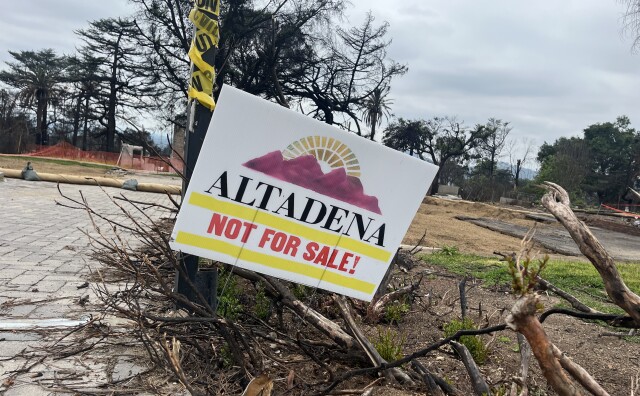Congress has cut federal funding for public media — a $3.4 million loss for LAist. We count on readers like you to protect our nonprofit newsroom. Become a monthly member and sustain local journalism.
It's Another Critically Dry Year After February Brings Little Rain

The peak of California’s rainy season is supposed to run from December through February. Now that period's come to an end, we have a decent idea of where we’re at in terms of water across the state.
In short: It doesn’t look good for either the flammability of local landscapes or our big stores of water already stressed by previous dry years.
“It’s a critically dry year,” said Chris Orrock, public information officer with the California Department of Water Resources.
“We’re probably in one of the bottom ten driest years on record for the state,” he said.

The more rain that falls locally, the wetter our hills, and the longer we’re likely to stave off serious fire concerns. Those fire concerns haven’t really gone away, with elevated fire weather still a problem when strong Santa Ana’s roar through.
Look at the rain totals and you’ll see why. Downtown Los Angeles has received less than half of the rain it should've had by the end of February. And Ojai, a perennial fire concern, has only received about 25% of expected rainfall. Similar conditions are present through much of the region.
March 1st update: 2020-2021 "wet season" in California remains dismally dry in most places. In fact, wide swaths of both NorCal & SoCal are well under 50% of average precipitation. It has also been a warmer than average winter overall, despite some cold interludes. #CAwx #CAwater pic.twitter.com/17afoE9spt
— Daniel Swain (@Weather_West) March 1, 2021
When it comes to water availability, it's the snowpack in the Sierra Nevada, the Colorado River Basin, and our above-ground reservoirs that we should look at.
While the storm in late January brought with it a good dumping of snow, we’re still only at 61% of normal snowpack across the Sierra. The Central and Northern portions are doing a bit better than the Southern Sierra, which is dragging the overall average down.
As of last week the Metropolitan Water District said that the snowpack in the Upper Colorado River Basin – which melts, runs down the Colorado River and is fed to L.A. – is sitting at 87% of normal.
As for our reservoirs, while a wet 2019 replenished them and kept them topped up through a dry 2020, we’re now starting to see them drop.
Shasta, the largest federally managed reservoir is at only 68% of its historical average, while Oroville, the largest state run reservoir is at 55%.
The likelihood we’ll get enough precipitation to catch us up through March is thin with the next two weeks looking exceptionally dry.
As Editor-in-Chief of our newsroom, I’m extremely proud of the work our top-notch journalists are doing here at LAist. We’re doing more hard-hitting watchdog journalism than ever before — powerful reporting on the economy, elections, climate and the homelessness crisis that is making a difference in your lives. At the same time, it’s never been more difficult to maintain a paywall-free, independent news source that informs, inspires, and engages everyone.
Simply put, we cannot do this essential work without your help. Federal funding for public media has been clawed back by Congress and that means LAist has lost $3.4 million in federal funding over the next two years. So we’re asking for your help. LAist has been there for you and we’re asking you to be here for us.
We rely on donations from readers like you to stay independent, which keeps our nonprofit newsroom strong and accountable to you.
No matter where you stand on the political spectrum, press freedom is at the core of keeping our nation free and fair. And as the landscape of free press changes, LAist will remain a voice you know and trust, but the amount of reader support we receive will help determine how strong of a newsroom we are going forward to cover the important news from our community.
Please take action today to support your trusted source for local news with a donation that makes sense for your budget.
Thank you for your generous support and believing in independent news.

-
People moving to Los Angeles are regularly baffled by the region’s refrigerator-less apartments. They’ll soon be a thing of the past.
-
Experts say students shouldn't readily forgo federal aid. But a California-only program may be a good alternative in some cases.
-
The program is for customers in communities that may not be able to afford turf removal or water-saving upgrades.
-
More than half of sales through September have been to corporate developers. Grassroots community efforts continue to work to combat the trend.
-
The bill would increase penalties for metal recyclers who possess or purchase metal used in public infrastructure.
-
The new ordinance applies to certain grocers operating in the city and has led to some self-checkout lanes to shutter.







